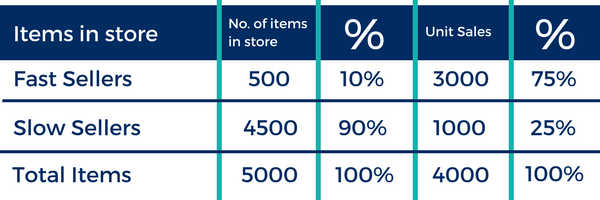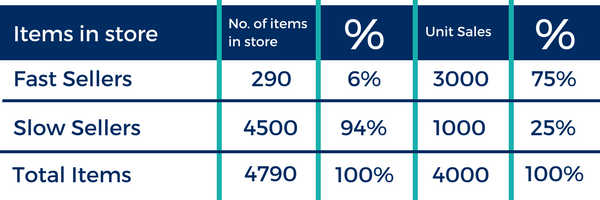Maintaining your best-selling inventory is, without doubt, the most critical area of your inventory control. Fast sellers are often only 5-20% of the average stores inventory but can be responsible for generating up to 80% of all storewide sales. Getting them back isn’t just important – it’s a necessity.
The crucial factor that is ignored is just how big an impact losing a few fast sellers can have. Let’s illustrate with an example:

This typical store has 10% of its inventory as good (fast) sellers (500 out of 5000 items). These good sellers are accounting for 75% of all store sales (3000 of the 4000 items being sold).
What happens if this store only reorders its fast sellers at the end of the month?
Let’s assume it sells, on average 10 items per day. If we know that fast sellers represent 75% of items sold then we can safely assume that 7 of the items (lets round it down to keep it simple) sold each day are fast sellers.
At the end of the month our sample store will have sold 210 items (7 items per day for 30 days) none of which will have been reordered. Let’s have a look at how the number of items in-store will appear now:

With 210 items sold and not reordered back the number of fast selling items for any customer walking in has dropped to only 290 pieces – or around 6% of the total inventory. Let’s put some dollars on this – imagine the original 500 items represented $50000 of saleable inventory. Let’s assume that the 290 items remaining represents $29000 of saleable inventory. You’ve just deprived your customers of $21000 (at cost) of good inventory to choose from – that’s $42000 retail value at keystone.
If your best-selling selection has dropped by 40% (500 down to 290) then what are your sales in danger of dropping by? You guessed it. 40%! You’ve just taken away 40% of the selection that matters so the chances of them buying have got to drop also.
“Oh, but they’ll just buy something else” you may say.
Let’s assume your average customer comes into your store 4 times per year, and the average length of time that your aged inventory has sat there is 18 months. That means your average customer has seen that “something else” six times already and has decided not to buy it. What are the chances that it’s suddenly the answer to all of their problems when they see it for the seventh time?
There are a few critical factors that make looking after your fast sellers all the more profitable:
- Send the reorders regularly. It’s one thing to be reordering fast sellers but don’t sit on those orders too long. We see many stores who reorder weekly or evenly monthly. Reorders should be processed daily for high volume items. The cost of a little freight (that should be factored into the cost price anyway) is nothing compared to the lost profit if you can’t sell it. Look at your daily sales report and get those fast sellers straight back in. Think of it this way – how can you sell more than 12 in a year if you only reorder monthly?
- Get it back on the floor within 24 hours. Nothing is worse than reordering daily and having the item arrive overnight to then have it sit in its parcel for a further 3 days –then the staff take another day to get it ticketed and on the floor. Make sure everybody knows how critical these key pieces are and give them the VIP treatment. Don’t leave them in the ‘coach’ queue when they deserve business class check-in!
- Maximize the mark up. There are plenty of dogs in store that you will have to special to quit. The profit you make each year is dependent on your fast sellers. Don’t discount them when you don’t need to and look at increasing their mark up if demand warrants it. The customers will soon show you the price the item is worth. When it comes back in, try putting a few more dollars on the retail price – you can always bring it back down. Jewelry retail is very much a case of supply and demand and if demand is high (read a fast seller) then prices can warrant a premium. The best example of this is Valentine’s Day. Would you expect to pay the same for a dozen red roses then as you would on May 21st? Of course not. Florists meet the market price and you need to do the same. Putting the same mark up on a fast selling item as a slow-moving one does not make sense. Sensible retailing is more than just applying a ‘cost plus’ mentality to each and every product.
- Keep them front and center. Your best sellers need the prime locations in-store where they are seen by the maximum amount of people. These are the pieces that will drive sales. Give them a chance to flourish in your best foot traffic areas.
If you would like ideas and strategies to ensure you have the healthiest inventory picture, going into the New Year, please contact The Edge Retail Academy and we will help you ensure more success during this important time of year. 877-569-8657, Ext. 1 or Becka@EdgeRetailAcademy.com






Leave A Comment